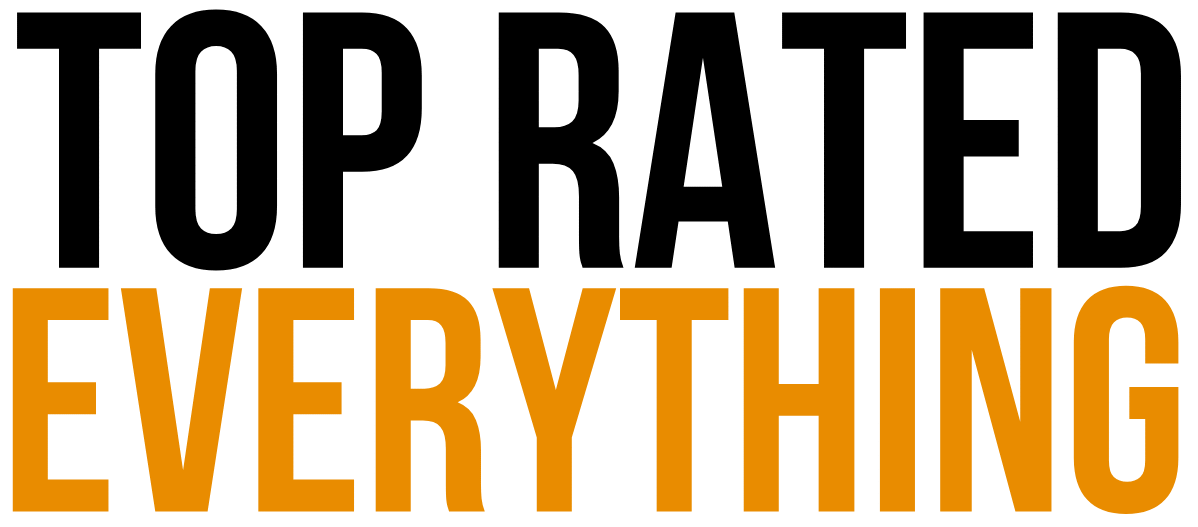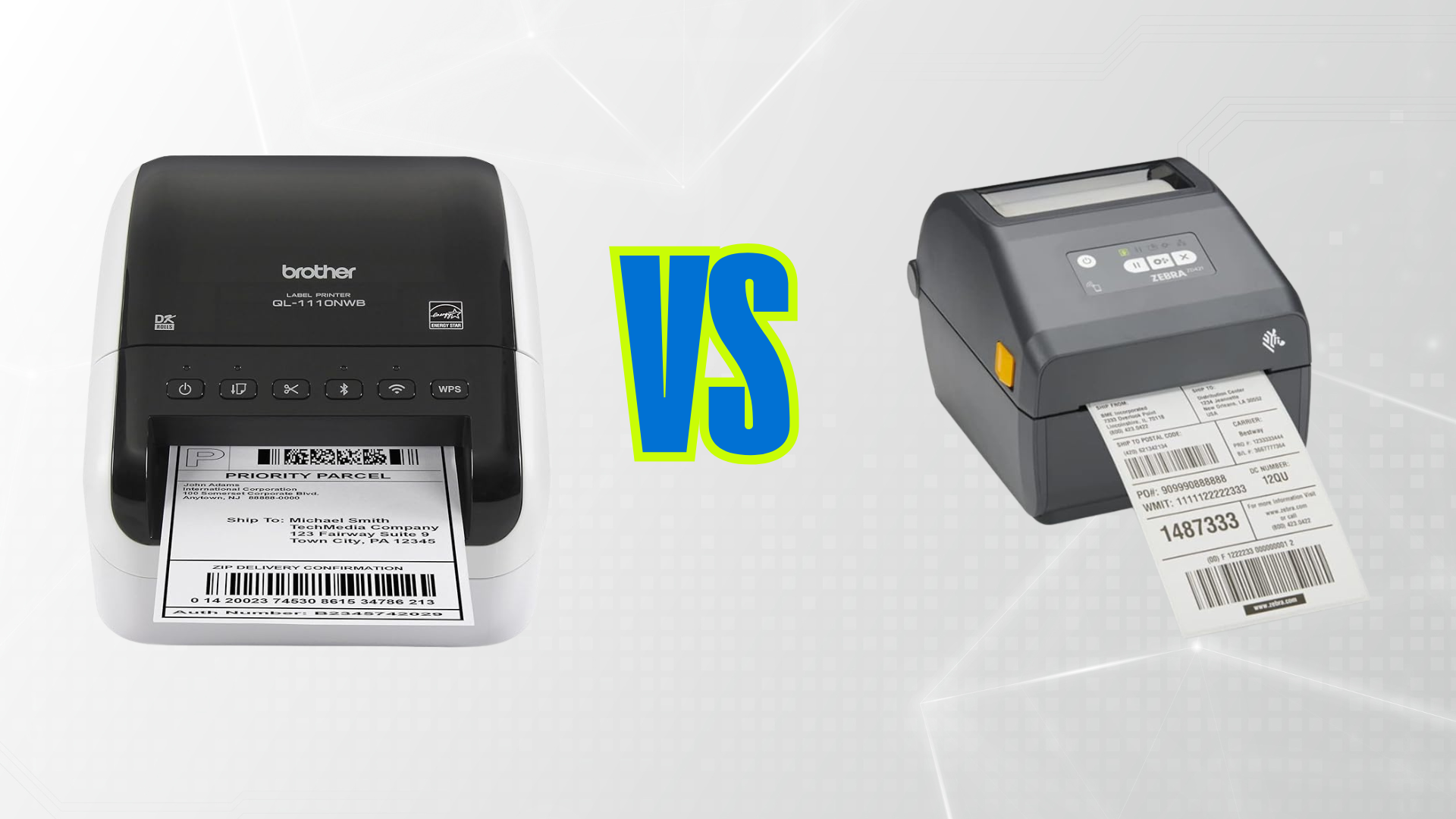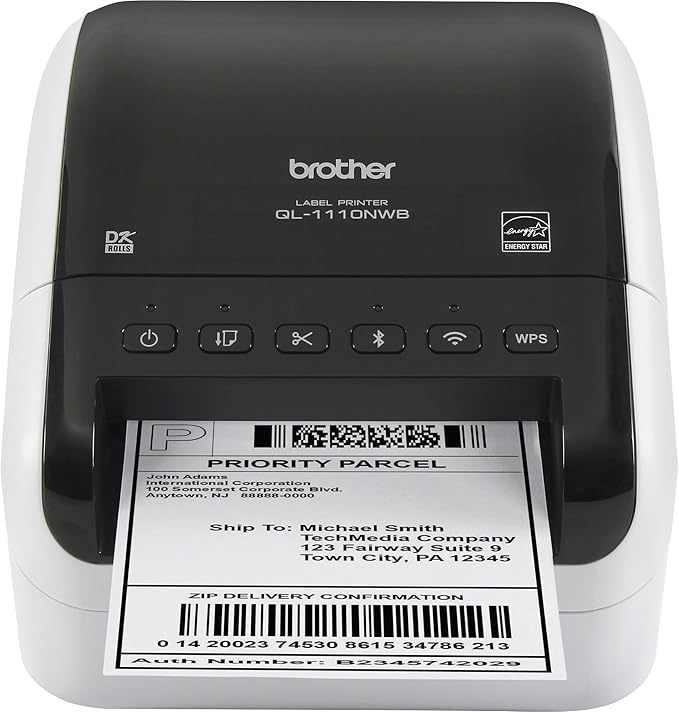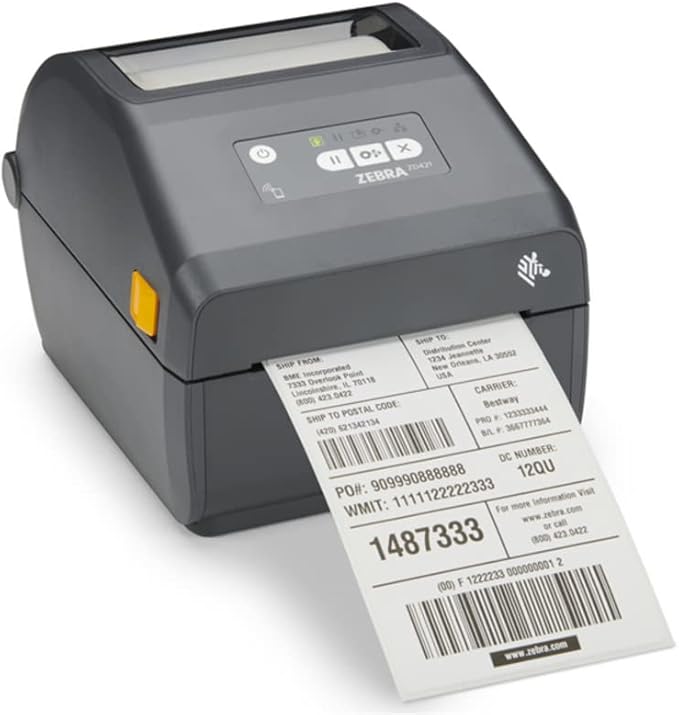If you’re shopping for a serious label printer to handle 4×6 shipping labels and beyond, two names come up fast: the Brother QL-1110NWB and the Zebra ZD421d. Both are direct-thermal desktop workhorses that avoid ink and toner, both print wide labels suitable for common carriers, and both have reputations for reliability. Yet they are built with different priorities. Brother’s QL-1110NWB is an office-friendly all-rounder with every common connection built in and a polished driver ecosystem that non-technical teams appreciate. Zebra’s ZD421d, part of Zebra’s commercial ZD400 line, is engineered for demanding benches—think long duty cycles, modular connectivity, and enterprise fleet tools. If you need a networkable printer that multiple desks can share with minimal fuss, Brother is compelling. If uptime, durability, and IT-grade manageability are paramount, Zebra is hard to beat.
In this in-depth comparison, we’ll lay out the specs and then examine Design & Setup, Features, Performance, Costs, and a clear Verdict, followed by a concise FAQ so you can pick the best label printer for your workflow.
| Specification | Brother QL-1110NWB | Zebra ZD421d |
|---|---|---|
| Printing technology | Direct thermal (inkless) | Direct thermal (inkless) |
| Maximum resolution | 300 × 300 dpi | 203 dpi standard, 300 dpi on select variants |
| Speed (class) | Up to ~69 address labels/min; ~4.3 in/sec for wide labels | Up to 6 ips (≈152 mm/s) depending on model/settings |
| Maximum print width | 4.0 in (supports 4×6) | 4.09 in (supports 4×6) |
| Connectivity | Wi-Fi, Ethernet, Bluetooth, USB, USB Host | USB 2.0, USB Host; optional Ethernet, dual-radio Wi-Fi + Bluetooth, Serial (varies by SKU) |
| Cutter | Auto-cutter | Optional/varies by configuration (tear bar standard) |
| Media ecosystem | Brother DK rolls (incl. DK-1241 4×6) + many compatibles | Broad Zebra + third-party media; extensive certified supplies |
| Typical environment | Shared small office, multi-desk packing, plug-and-play deployments | High-duty benches, managed fleets, regulated/industrial settings |
Design & Setup
Brother QL-1110NWB
Brother’s design brief is “drop it on a desk and it just works.” The QL-1110NWB comes with Wi-Fi, Ethernet, Bluetooth, USB, and even a USB Host port out of the box, so you can deploy it in almost any environment without buying add-ons. That matters if you’re not sure how your setup will evolve—today it sits on USB at one workstation; tomorrow you hard-wire it to Ethernet and share it across the room. The auto-cutter keeps edges tidy for single labels or continuous runs, and Brother’s drivers/utilities are mature for both Windows and macOS. For non-technical teams, setup tends to be smooth: install the driver, pick the label size, and start printing.
Zebra ZD421d
Zebra’s ZD421d is a commercial desktop unit built for long days. The interface uses five status LEDs and three buttons, so operators can see at a glance if the printer is paused, out of media, or in error. Zebra’s OpenACCESS clamshell and color-coded media path speed up reloads and reduce mistakes. Connectivity is modular: base models ship with USB/USB-Host, while other SKUs add dual-radio 802.11ac Wi-Fi + Bluetooth, Ethernet, or Serial—useful when you need specific security or infrastructure constraints. In settings with multiple printers, Zebra’s provisioning and remote-management tools help IT deploy and monitor devices consistently.
Takeaway: If you want “every port, no decisions,” the Brother wins on simplicity. If you prefer to choose an exact connectivity/security package and value serviceability, the Zebra feels purpose-built.
Features
- All-in connectivity makes sharing trivial (no external print servers required).
- 300-dpi output produces crisp text and graphics—handy for small QR codes, SKU labels, or dense return addresses alongside shipping.
- The auto-cutter is great for mixed runs and reduces hand-tearing errors.
- Brother’s driver and template ecosystem is broad; if your office already uses other Brother labelers, standardizing simplifies training.
- 203-dpi standard is perfect for carrier barcodes; 300-dpi variants are available if you print micro-text or dense 2D codes.
- Rated up to 6 ips, it’s built for sustained throughput.
- Link-OS tools, setup apps, and SDKs support enterprise workflows (remote updates, monitoring, security policies).
- Zebra’s catalog of certified supplies helps when you need documented label quality for compliance or harsh environments.
Takeaway: Brother packs a complete, office-friendly kit into one SKU. Zebra offers a platform with options and enterprise tooling—ideal when you print all day, every day, or need IT controls.
Performance
Both printers are genuinely fast; the practical bottleneck is often your workstation, network, or shipping software.
- Brother QL-1110NWB churns out wide labels at a brisk clip and shines in multi-desk scenarios where several users print throughout the day. Hard-wiring it over Ethernet yields stable, repeatable jobs with minimal lag. The 300-dpi head delivers visibly cleaner small text and logos compared with 203-dpi units, which can matter for receiving labels or compact QR codes.
- Zebra ZD421d keeps pace with sustained 4–6 ips output, and its diagnostics help operators catch issues quickly. In continuous, high-duty runs—think a packing bench that never sleeps—the combination of speed, straightforward status indicators, and easy media changes reduces stoppages. If you choose a 300-dpi variant, you gain extra detail headroom without sacrificing the platform’s reliability.
Takeaway: Speed is effectively a wash for most 4×6 shipping tasks. Choose based on consistency and environment: Brother for easy office sharing; Zebra for heavy-duty, monitored benches.
Costs
Both are direct-thermal—no ink or toner—so your recurring expense is labels.
- Brother QL-1110NWB: Uses the DK label system. Official DK rolls are widely available and consistent, and there’s a healthy market of compatible supplies to manage cost. If your office already stocks DK media, standardizing is convenient. Hardware pricing is mid-range; value comes from the “everything included” connectivity and the auto-cutter.
- Zebra ZD421d: Supports common 4-inch direct-thermal media, with a large ecosystem of third-party options. Zebra also sells certified supplies, which some regulated industries require. Upfront cost can be higher than general office units, and adding Ethernet/Wi-Fi or a 300-dpi head increases price—but those options often pay back in uptime, fleet control, and lifespan when the printer works all day.
Total cost of ownership: For a small office that needs one shareable printer with minimal decisions, Brother’s all-inclusive connectivity can reduce setup/support costs. For high-duty environments, Zebra’s longevity, diagnostics, and manageability lower downtime and reprint waste over years.
Verdict
Winner for most small offices and multi-desk teams: Brother QL-1110NWB. It’s the most “plug-and-share” label printer with Wi-Fi, Ethernet, Bluetooth, USB, and a USB Host port included, plus a 300-dpi head and auto-cutter that make daily use easy.
Choose the Zebra ZD421d if your operation runs a high-duty bench or requires enterprise features: modular connectivity (including dual-radio wireless and Ethernet), optional 300-dpi, robust status/diagnostics, and fleet tools for provisioning and monitoring. For continuous, IT-managed workflows, Zebra’s commercial design pays dividends.
Both are excellent; buy for your environment: office-friendly versatility (Brother) or industrial-grade reliability and control (Zebra).
FAQ
Are these printers inkless?
Yes. Both are direct-thermal printers, so they use heat-sensitive labels and never require ink or toner—only label media.
Which one is faster for 4×6 shipping labels?
In practice, both are very fast. The ZD421 platform is rated up to 6 inches per second; the Brother delivers brisk wide-label output with an official spec that translates to roughly ~110 mm/s. For typical e-commerce batches, the difference is minor versus workflow and connection type.
When does 300-dpi matter?
If you print tiny text, dense 2D codes, or small branded marks, 300-dpi yields cleaner edges and fewer scanner misreads. For standard carrier barcodes and shipping graphics, 203-dpi is sufficient.
Which is easier to share across multiple computers?
Brother QL-1110NWB. Every common port is built in (including Ethernet), so you can drop it on the network with minimal setup. The Zebra ZD421d can also be shared—choose a configuration with Ethernet or dual-radio Wi-Fi if that’s your plan.
What about label costs?
Both accept widely available 4-inch direct-thermal media. Brother uses the DK system (official and compatible rolls are easy to source). Zebra supports a broad set of media and offers certified supplies for environments that need documented quality.
Which should I buy?
Pick Brother QL-1110NWB for a versatile, shareable office label printer with great print quality and an auto-cutter. Pick Zebra ZD421d for heavy daily use, IT management, and long-term durability, especially if you want modular connectivity and optional 300-dpi.
Also check out: Rollo Wireless X1040 vs Zebra ZD421d: Which is Better?, Rollo Wireless X1040 vs Brother QL-1110NWB: Which is Better?



